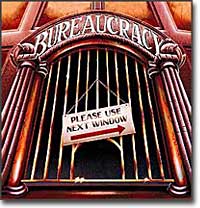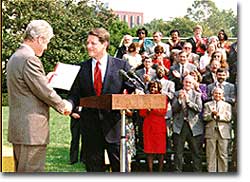8d. Reforming the Bureaucracy

The bureaucracy is notorious for being out of touch with the people and difficult to navigate, a fact illustrated in cartoons, jokes, and even video games.
Since 1980, virtually every presidential election included a debate over the size of the federal government. Americans who believed the bureaucracy had become too large, too expensive, and too powerful were becoming more numerous, and as a result many politicians began to demand reform.
Bureaucracies move slowly. One hand doesn't always know what the other is doing. Federal employees have so much job security that there is little fear of being fired for incompetence. There are so many agencies organized in such confusing ways.
How can the ordinary citizen feel connected to government when everything is so impersonal? Public criticism of bureaucratic inefficiency is commonplace. In response, many people, including most Presidents, have tried to reform and reorganize the bureaucracy.
The Merit System and the Hatch Act

Government employees may not wear campaign buttons (like this one of President McKinley) at work, or while wearing a uniform or driving a government vehicle, according to the provisions of the Hatch Act.
The merit system tries to ensure that the best-qualified people get government jobs and that party politics is limited. In 1939, Congress passed the Hatch Act, which required employees, once they were hired, to have as little to do with political parties as possible. The Hatch Act forbids employees from engaging in many party activities. For example, they could not run for public office or raise funds for a party or candidate, nor could they become officers in a political organization or a delegate to a party convention.
In the early 1970s some bureaucrats complained that their First Amendment rights were being violated. The issue made its way to the Supreme Court, where the justices ruled that the Hatch Act did not put unreasonable restrictions on employees' rights. However, in 1993 Congress softened the Hatch Act by making many forms of participation in politics permissible. Federal bureaucrats still cannot run as candidates in elections, but they may be active in party politics.
Requiring Accountability
One criticism of our merit-based bureaucracy is that once a person is employed there are no requirements that he or she be held accountable for their work. Since they no longer lose their jobs when a new President takes office, some criticize that they become complacent and inflexible. Some suggestions for making civil servants more accountable for their work include the following:
- Limiting appointments to 6-12 years. After the appointment expires, the bureaucrat would then have to go through reexamination and their performance would be reviewed for possible rehire.
- Making it easier to fire a bureaucrat. Civil service rules that are meant to protect workers from partisan politics have made it difficult to fire anyone for poor performance. Reformers want to remove those rules.
- Rotating professionals between agencies and from outside. Reformers believe that this practice would bring "new blood" to agencies and encourage workers to get a broader view of government service.

One of the public's greatest complaints about the bureaucracy is red tape. Many feel that the government's methods of solving problems is to drown them in a sea of paperwork.
Cutting "Red Tape"
One common complaint about bureaucracy is that "red tape" — the maze of government rules, regulations, and paperwork — makes government so overwhelming to citizens that many people try to avoid any contact. Filling out forms, standing in line, and being put on hold on the telephone all have resulted in many people being discouraged from ever applying for benefits they rightfully deserve.

Al Gore presents the report of the National Performance Review (later renamed the National Partnership for Reinventing Government) to President Clinton in 1994.
In response, Presidents of the 20th century offered no fewer than eleven major reorganizations of the federal bureaucracy. The latest was the National Performance Review, conducted by Vice President Al Gore in 1993. The NPR report contained many horror stories about useless red tape for both citizens and government officials themselves. The NPR called for less centralized management, more employee initiative, fewer rules, and more emphasis on customer satisfaction. As of the year 2000, few of the recommendations have been followed.
One reason that it is so hard to reform the bureaucracy is that it has two masters — the President and Congress. Especially during periods of divided government, one branch can be suspicious that the other is trying to gain control. As a result, one branch or the other resists reform. Finding the practical solutions that have bipartisan support is a difficult process, largely because the system of checks and balances is not particularly efficient. Nevertheless, bureaucratic reform is often attempted by the President and Congress. Meanwhile, the red tape remains rather sticky.







